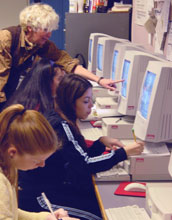Multimedia Gallery
Modeling Across the Curriculum (Image 1)
Modeling Across the Curriculum (Image 1)
Tenth-graders from Lowell High School in Lowell, Mass., participate in the Modeling Across the Curriculum Project, or MAC, a five-year research project to study the impact of computer modeling tools on secondary-level science learning. The project is a partnership between the Concord Consortium, Harvard University, Northwestern University, the Center for Learning Technologies in Urban Schools (LeTUS), the Fitchburg Public Schools, the Boston Public Schools, and the Lowell Public Schools.
Tools called CIE models incorporate core science content that students learn through interaction and exploration. The project explores the hypothesis that students learn more through such models by testing it in real schools. Using a variety of computer-based manipulative models and probeware, the program teaches students how to create, refine and apply mental models to improve their understanding of science.
This research was supported by National Science Foundation grant REC 01-15699, "Modeling Across the Curriculum." (Date of Image: 2002) [One of three related images. See Next Image.]
Credit: The Concord Consortium
Images and other media in the National Science Foundation Multimedia Gallery are available for use in print and electronic material by NSF employees, members of the media, university staff, teachers and the general public. All media in the gallery are intended for personal, educational and nonprofit/non-commercial use only.
Images credited to the National Science Foundation, a federal agency, are in the public domain. The images were created by employees of the United States Government as part of their official duties or prepared by contractors as "works for hire" for NSF. You may freely use NSF-credited images and, at your discretion, credit NSF with a "Courtesy: National Science Foundation" notation.
Additional information about general usage can be found in Conditions.
Also Available:
Download the high-resolution JPG version of the image. (2 MB)
Use your mouse to right-click (Mac users may need to Ctrl-click) the link above and choose the option that will save the file or target to your computer.

